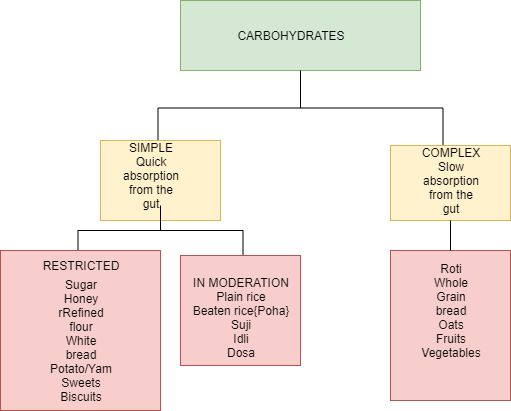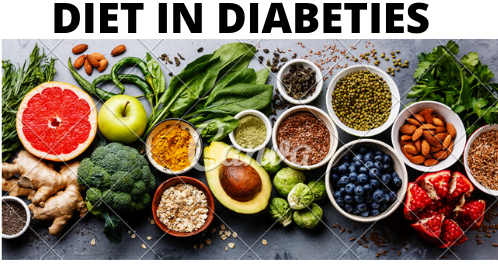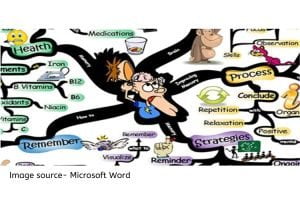 How Having A Healthy Carbohydrate Diet can Help Control Your Diabetes
How Having A Healthy Carbohydrate Diet can Help Control Your Diabetes
Table of Contents
Introduction- Carbohydrates
The diet of a diabetic patient determines the effect his diabetes has on the different organs in his body and having healthy carbohydrates as a part of one’s prudent diet can help him or her in maintaining healthy blood sugar levels.
A well-planned diabetic diet prevents many common complications such as hypoglycemia, diabetic ketoacidosis, eye disease [retinopathy], a kidney disease[nephropathy] which can affect one suffering from diabetes.
What you eat and what you should eat determines your blood sugar and HbA1C levels. What you are eating at present shows up in your body build- it may be ideal, overweight or obese.
Depending upon your body type, if you are diabetic, we have to either increase or decrease calorie intake to maintain your ideal body weight. Regular exercise and proper diet management can help to achieve this. Calculate your ideal body weight by using this app-
Once you know your Ideal Body Weight, I would suggest that you use this gadget every 10 days until you achieve your goal. If you follow the instructions on your diet strictly, it should not be that difficult to achieve your ideal body weight. Read on ahead on how to do it.
In my previous post, I mentioned in the early part regarding the Balanced Diet.
A balanced diet- the food we eat- has 3 main food components, called macronutrients as shown below-
1] Carbohydrates-
This constitutes about 50 to 60% of the total calories required.
2] Proteins-
Approximately 15 to 20% of the energy requirement
3] Fats–
This makes up 25 to 30 % of the rest of the total calories required.
We will now discuss each of these in detail. In today’s article, I will be focussing on the major component of the food- the carbohydrates in our diet. I will also be detailing the quantity and quality of carbohydrates a diabetic patient should consume. So, let’s begin-
Carbohydrates-
are those parts of the food we eat that supply us the energy to work. Carbohydrates, as shown in the diagram given below comprises of 2 types-

SIMPLE CARBOHYDRATES-
Most of the sugars-dextrose, maltose, sucrose, fructose- to name a few, come under simple carbohydrates.
These are absorbed immediately and give us almost instant energy. They are also called refined sugars. They usually have a high Glycemic Index (GI). Fructose is the sugar that is found mostly in fruits.
( Glycemic Index of a food is a unit based on the amount of sugar present in a food item compared to 100 gm of pure sugar[which is 100 GI]. For eg. if 100 gm of an apple contains 55 gm of sugar, then it’s glycemic index is 55. It ranges from 0 to 100)
Can you eat fruits and if so, which ones?
Assuming you are a diabetic, I would recommend the following fruits in your diet-
- Those which can be eaten without peeling for eg. Apple, pears, guava, berries like strawberry, raspberry, grapes( in moderation) because their peel contains fiber which helps in not only slow absorption of the fructose but also contains antioxidants, especially those that are colorful like blueberries, which is beneficial for diabetes.
- Fruits that have to be peeled like a banana, watermelon, orange, etc., should be eaten in moderation because they can raise blood sugar levels.
- Avoid dry fruits like dates, raisins, etc., as they contain high amounts of sugar even though they contain high amounts of fiber.
- Do not consume fruit juices of any fruits as well as cooked ones because they are void of fibers and antioxidants and full of highly absorbable sugar.
Alternatively, you can consume foods that have a low glycemic index. You can get the glycemic index of any food by visiting this site. This site will also give you the Glycemic Load (explained below) of many food items we consume.
Is eating 100 gm of apple the same as eating 100 gm of potato? No. Why? Because of the Glycemic Load.
What exactly is the Glycemic Load(GL) of a food item? It is the amount of carbohydrates in any food item of equal quantity (which differs from food to food) multiplied by the GI of that item and then divided by 100. Let us go back to to above example of apple and potato.
100 gm of apple contain 15 gm of carbs and GI of 40. 100 gm of potato has 23 gm carbohydrates and GI of 80. Let’s calculate their individual GL-
- Apple- (40×15÷100=6)
- Potato-(80×23÷100=18)
In the above example, potato with GL of 18 is 3 times that of an apple. This means by eating 100 gm of potato your blood sugar is bound to rise 3 times more than that of 100 gm apple.
So, knowing the GL of the food you are eating is equally important, because you can decide how much of that item you can eat.
COMPLEX CARBOHYDRATES-
– these are the starch[digestible part] and fiber [undigestible part] . They are found in cereals, pulses and root vegetables like potato, yam, etc.
Most of the time, the starch gets metabolized to glucose after digestion. This can spike up your blood sugar if not eaten in moderation.
Fiber is that part of the food which remains undigested. It does not contribute to the rise in blood sugar levels. It helps in the formation of stool and evacuation of the bowel. The human intestine is not capable of digesting fiber. Hence it forms the bulk of the excreted stool.
*50 gm of dietary fiber per day in the diet is known to help to lower fasting blood sugar levels in diabetes.
- Most vegetables and fruits are a good source of dietary fiber.
- Dietary fiber is also known to make you feel full thereby reducing the intake of more food and simple sugars.
- They also remove toxic waste through defecation.
- Reduce cholesterol levels in the blood.


Adult women need a minimum of 20 gm and men 38 gm of fibers in the diet.
How many grams of carbohydrates do you need daily?
Our brain needs a minimum amount of 130 gm/day of carbohydrates in the form of glucose to keep it working.
Again, this varies in individuals suffering from diabetes depending on the type and dosage of the medication.
To know the exact amount of carbohydrates you need per day, you will have to calculate your BMR.
This gadget shown below will get you your BMR as well as the required calories per day depending upon your gender, height and weight-
After getting your total energy requirements, calculate 60% of this value. This your approximate carbohydrate calories. Divide this value by 4( 4cals equals 1 gm of carbohydrates) – this is your daily requirements of carbs.
Knowing how much carbs you need for the entire day, you can then divide it per meal, for eg. breakfast/lunch/teatime/dinner and distribute them accordingly.
How many carbohydrates should you reduce or add?
Now, let us go to the Ideal bodyweight you have calculated earlier.
- Minus this value, if your weight is more or add this to your present weight if you are underweight.
- Multiply this by 4. These are your excess calories. Add this to your total daily requirement (TDR )if you are underweight or minus this from the TDR if you are overweight.
- Now calculate 60% of this value- your carbohydrate calories- and divide by 4. Done.
- This is the number of carbs in grams which you should add or minus depending upon your present weight.
Is there a replacement for sugar in my diet?
Yes, you can replace the sugar you are using in your diet by an artificial sweetener like Stevia powder or stevia liquid. One sachet or one drop of this is equal to 1 teaspoon of sugar but has almost zero calories.
The website–www.dlife.com– will give you details of commonly consumed carbohydrates or foods with a low glycemic index.
Are all carbohydrates good for health?
Not all carbohydrates are good for health. According to Dr. Walter C. Willet, MD, of Eat, Drink, And Be Healthy, Harvard Medical School of Healthy Eating-
Eating rapidly digested starches, like those in white bread, a baked potato, or white rice, causes a swift, high spike in blood sugar followed by an equally fast fall. This blood sugar roller coaster—and the insulin one that shadows it—triggers the early return of hunger pangs. These starches are also implicated as part of the perilous pathway to heart disease and diabetes. The harmful effects of rapidly digested carbohydrates are especially serious for people who are overweight.
The carbohydrates in whole grains, such as oats or brown rice, in foods made with whole grains, like whole-wheat pasta or bread, or in beans have a slow, low, and steady effect on blood sugar and insulin levels. This helps you feel full longer and keeps you from getting hungry right away. Whole grains and other sources of slowly digested carbohydrates give you important fiber plus plenty of vitamins and minerals. They also protect you against heart disease and diabetes. These are the carbohydrate sources that should form the keystone of a healthy diet.
Conclusion
Now that you are aware of which carbohydrates you can eat, I will be highlighting on the other two components of your diet- the proteins and fats-in my next post shortly.
If you have any suggestions or queries be free to do so by emailing me at-drrao@raodoctor.com or by subscribing to my post, free of cost.
To know more about carbohydrates in your diet, visit this site- diabetes.org







